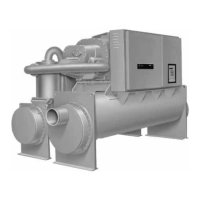Interprocessor Communication (IPC)
RTHC-SVD01B-EN 59
Section 12 Interprocessor Communication (IPC)
12-1. General
The respective modules communicate with each other via an InterPro-
cessor Communication link (IPC). The IPC link allows the modules to
work in a coordinated manner with the Chiler Module (1U1) directing
overall chiller operation while each module handles specific subfunc-
tions. This IPC link is integral and necessary to the operation of UCP2
and should not be confused with the Optional ICS (Integrated Comfort
System) communication.
In the IPC communication protocol scheme, the 1U1 acts as the initia-
tor and the arbitrator of all module communication. The 1U1 essentially
requests all the possible “packets” of information from each module in
turn, (including itself), in a predefined serial sequence. The other mod-
ules act as “responders” only and cannot initiate communication. Mod-
ules which are not currently responding to a specific request, can listen
to the data and thus, indirectly, communicate with each other. It is help-
ful to remember when troubleshooting that a module must be able to
hear a request for its information from the 1U1, or it will not answer.
The link is non-isolated, which means that a good common ground
between all modules is necessary for trouble-free operation (provided
by the module enclosures' mounting using star washers and a ground
wire to the CLD). Also, the link requires consistent polarity on all mod-
ule interconnections. Connections between modules are made at the
factory, using unshielded 18 gauge twisted pair cable. This connector
is plugged onto the 4 pin IPC connection jack designated as J1,
located in the corner of the PC board edge on all of the modules. The 4
pins actually represent 2 pairs of communications terminals (J1-l (+)
internally connected to J1-3, and J1-2 (-) internally connected to J1-4).
12-2. IPC Diagnostics
The modules, in order to work together to control the chiller, must con-
stantly receive information from each other over the IPC link. Failure of
certain modules to communicate or degradation of the communication
link, could potentially result in chiller malfunction. To prevent this situa-
tion, each module monitors how often it is receiving information from
other designated modules. If a module fails to receive another mod-
ule's transmitted data over a 15 second time period it will:
1. Take specific action to safely shut-down (or to default) its con-
trolled loads.

